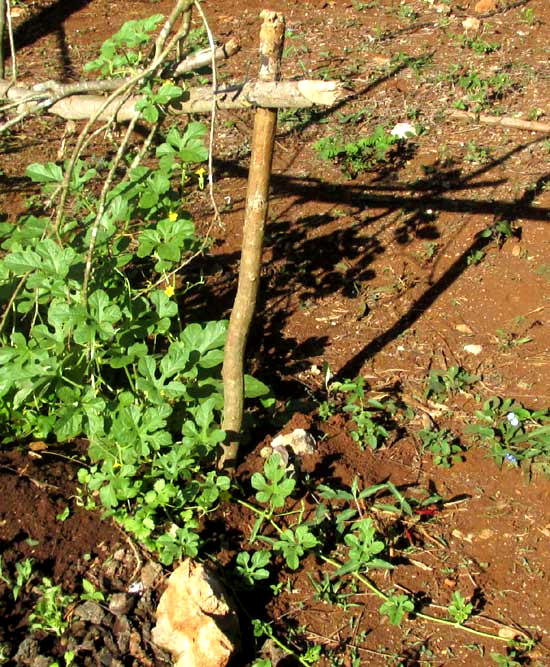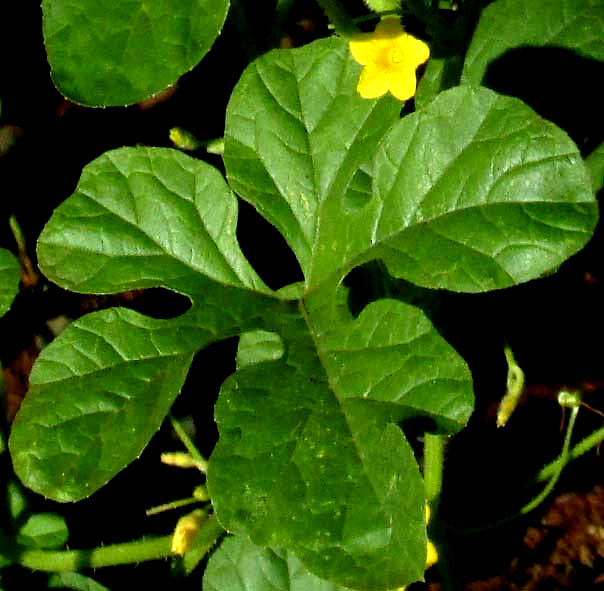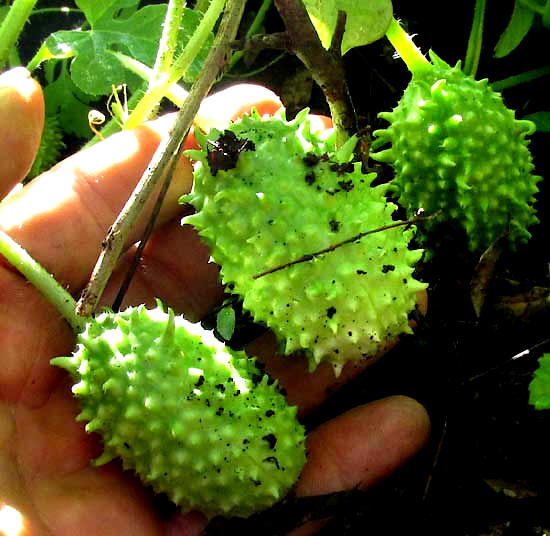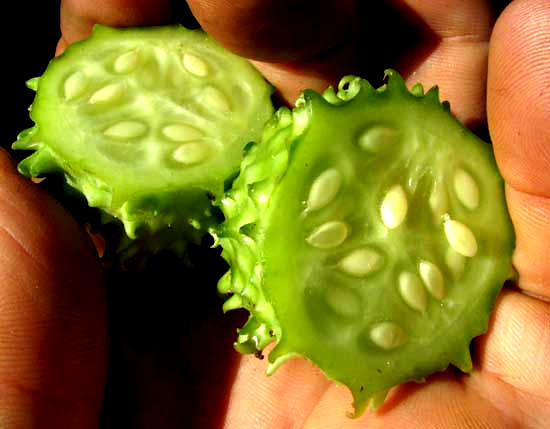Excerpts from Jim Conrad's
Naturalist Newsletter
from the January 22, 2017 Newsletter issued from Rancho Regenesis in the woods ±4kms west of Ek Balam Ruins; elevation ~40m (~130 ft), N20.876°, W88.170°; north-central Yucatán, MÉXICO
SPINY CUCUMBERS
About two months ago in Mérida my friend Eric handed me a egg-sized, egg-shaped, green fruit thickly armored with fleshy spines, and said that it was a cucumber he'd bought just because it was interesting. Cutting it open, it looked like a regular cucumber inside, smelled like a cucumber and tasted like a cucumber. I couldn't wait to see if the seeds would germinate and, if so, what kind of plant would produce such a fruit. Seed germination was close to 100%, and the resulting plant grew like a weed in the garden, with no special attention other than daily waterings. Below, you can see what it looks like now:

I'd guessed that the plant would be a vine closely related to regular garden cucumbers, so as the picture shows I supplied scaffolding for the vines to climb. The plants did quickly develop into vines with tendrils, but the stems showed no interest at all in climbing. In the picture the plant appears to be ascending the scaffolding but that's because I draped the stems there, hoping they'd get the idea. However, now it's clear that these vines want to run on the ground as if they were Watermelon vines. In fact, the leaves are deeply lobed somewhat like Watermelon leaves, as you can see below:

Each vine produced both unisexual male and unisexual female flowers, the latter displaying very prickly ovaries positioned below the calyx and corolla, befitting a member of the Cucumber Family, as shown below:

In that picture, on the right, the prickly ovary is easy to see. In the picture's center there's a tangle of frustrated tendrils unable to find anything to wrap around other than themselves, and at the left there's a male flower with no ovary. The vines began producing flowers and fruits very early, when they bore only two or three leaves, and the fruits developed fast. Below, you can see some almost-mature fruits:

Below, you can see how a cut-open fruit looks just like a cucumber inside:

In fact, you could say that this really is a cucumber because the species is a member of the genus Cucumis, which is the cucumber genus (as well as that of the Muskmelon). Our spiky-fruited vine is CUCUMIS ANGURIA, which many gardeners call Spiny Cucumber, but which in much of the world is known as the West India or Bur Gherkin. In North America often the name "gherkin" is used for pickles made of young regular garden cucumbers, so that name can be a little confusing to us.
The binomial Cucumis anguria is a good old Linnaeus one, so Spiny Cucumbers have been known about for a long time. Normally they're grown only for their novelty, however, the general opinion being that if you want to eat cucumbers, and you can grow the regular garden cucumber, Cucumis sativus, why bother with the small, prickly Cucumis anguria? Still, when I'm working in the garden I enjoy popping a whole spiny one in my mouth and eating it as-is. The spines are so soft and fleshy that they don't bother at all.
The Flora de Nicaragua states that Cucumis anguria is native to Africa. However, the species has become naturalized in many tropical and subtropical countries. In fact, we've found it growing as a weed here in the Yucatán, though the spines on those fruits were much smaller than those on our garden ones. Our weedy Spiny Cucumber is shown at www.backyardnature.net/yucatan/cucumber.htm